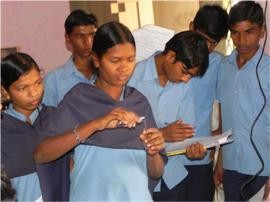Snehal Asdul from Piranche village is now an engineering student in a Pune college. Source: MAMB
The two are among 60 school children — 39 of them girls — identified as 'little scientists' by a Pune-based private academy that is scouting for such talent in rural India. The Moving Academy of Medicine and Biomedicine is the brainchild of Madhav Deo, former director of the Cancer Research Institute in Mumbai.
"India currently has about 120,000 scientists, just about a tenth of the number in the United States," Deo told Nature India . "This 'creative pool' can be tripled by tapping the intellectual capital that resides in these neglected villages, which account for 70% of India's population."
Deo's arithmetic is based on logic. "Creativity and talent are evenly distributed among the population irrespective of caste, creed, religion, socio-economic status or geographical location," he says. However, existing government schemes to nurture talent are city-centric and biased towards students well-versed in English. Rural India, therefore, remains untapped. "Our aim is to spot these 'little scientists' in the hope that they will eventually join the scientific workforce."
The faculty members of the academy drive down to the villages during the summer vacation to spot India's future scientists. Their visit is widely publicised in local newspapers encouraging senior school students to join the 'little scientists' programme. "The idea is to spot students with research aptitude," says Rita Mulherkar, a molecular biologist and treasurer at the academy.
Weekend research programmes, mobile science fairs and hands-on workshops in village schools are also part of the selection process. The young scientists are interviewed and selected through an essay on topics such as diabetes, heart attack, cancer, stem cells, gene cloning and genetics. The selected ones undergo a week-long orientation.
Snehal Asdul from Piranche village is now an engineering student in a Pune college. Source: MAMB
With periodic grants from a philanthropic organisation, Sir Dorabji Tata Trust, the academy has been able to scout for talent in seven villages in three districts of Maharashtra. Lack of resources has not allowed it to spread wings.
The innovative scheme will also provide laboratory access to the students through a base laboratory that connects with a number of Regional Hubs for Science & Technology (RHST). Each of these hubs will, in turn, network with schools in that region. The Academy is establishing one such hub in Parinche village with modest laboratory facilities.
"Creation of some 1500 RHSTs in the entire country will bring laboratory facilities within a radius of 25 km of each village and change the face of science and technology in rural India," Deo says. Each RHST will cost about Rs 50 million for creation and Rs 10 million for annual maintenance.
Deo, who is 80 and dedicated to the cause, says suitable mechanisms should be evolved to financially support the 'little scientists' until they join the country's scientific workforce. "With this in view we have submitted a project to the government Department of Science and Technology for funding." As of now the youngsters are funded mostly by well-meaning donors.
Deo says there is an urgent need to reproduce the success of the programme in other regions of the state before the concept can be adopted nationally.
